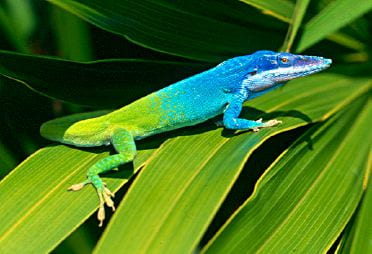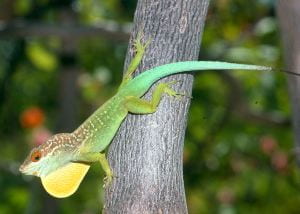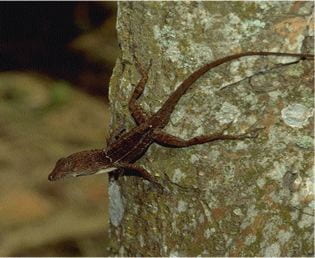
The primary focus of the Losos Lab is on the behavioral and evolutionary ecology of lizards. Major questions concern how lizards interact with their environment and how lizard clades have diversified evolutionarily. Addressing such questions requires integration of behavioral, ecological, functional morphological, and phylogenetic studies. A major focus has been the evolutionary radiation of Caribbean Anolis lizards, but other lizard radiations are also being studied.
Anolis is the largest amniote genus with approximately 400 described species. Nearly 150 of these species occur in the Caribbean. Two patterns of interest occur on the islands of the Greater Antilles (Cuba, Hispaniola, Jamaica, and Puerto Rico). First, on any of these islands, anoles are often extremely abundant. At any given spot, one can often easily find 4-6 species (the maximum is 11 at Soroa, Cuba). These species occupy different microhabitats (e.g., one lives on twigs in the trees, another in the grass, a third on tree trunk near the ground, and each is morphologically and behaviorally different. For example, twig anoles tend to be slender with short legs and tails, whereas the trunk-ground anoles are stocky, with long legs and poorly developed toepads. In all, six such habitat specialists are recognized, termed “ecomorphs” and named for the part of the habitat they occupy.
Most strikingly, when one goes to different islands among the Greater Antilles, one sees essentially the same set of ecomorphs on each island (with several exceptions). For example, if one saw a twig anole on Puerto Rico, one could go to each of the other islands and see a very similar looking animal living in the same sort of habitat and behaving similarly. For the most part, this is true for each of the ecomorphs.


This raises a number of questions. First, have these ecomorphs evolved independently on each island, or have they each evolved only once and someone come to occupy each island? Phylogenetic studies using mitochondrial DNA, conducted by Todd Jackman, in collaboration with Allan Larson and Kevin de Queiroz of the Smithsonian’s National Museum of Natural History, clearly indicate that members of the same ecomorph class on different islands are not closely related. Hence, the similar assemblages on each island are the result of convergent evolution. Although such a phenomenon has been suggested in the past for other groups, it has never previously been demonstrated phylogenetically.
Given that species on different islands have evolved similar morphologies to live in similar habitats, the obvious hypothesis is that the morphologies reflect adaptations to those habitats. However, to understand why a particular feature is adaptive in a particular microhabitat (e.g., why short limbs should evolve in twig species), we need to know what consequences differences in morphology have for these lizards and whether such functional differences are relevant to lizards in nature. To answer the former question, we bring lizards into
the lab and measure their functional capabilities in ecologically relevant ways, such as maximum sprinting, jumping, and clinging capabilities. These studies, many of which were conducted by Duncan Irschick, indicate that differences in limb length result in differences in sprinting and clinging capabilities. Similarly, differences in toe pad dimensions are related to clinging ability. Moreover, it turns out that the relationship between morphology and performance ability is context-dependent; for example, long legs confer enhanced sprinting ability on broad, but not narrow surfaces.
Field studies are then necessary to assess whether these functional differences make any difference to the organisms. Not surprisingly, they do. Species in different habitats use different surfaces and move in different ways. In escaping predators, lizards make use of their maximal sprinting capabilities. Moreover, it appears that species are adapted to perform best in the environment and with the lifestyle (foraging behavior, escape strategy, etc.) they utilize. Nonetheless, not all performance abilities are taken advantage of: for example, lizards rarely use their maximal jumping capabilities. Much of this field work was also conducted by Duncan Irschick.
An unexpected finding is that habitat specialists are convergent not only in morphology and behavior, but also degree of sexual dimorphism. This indicates that the ecomorph phenomenon is much more pervasive than simply reflecting adaptations to different modes of locomotion. Most likely, patterns of territoriality and sexual selection are also involved. Marguerite Butler’s thesis focused on the interaction of sexual differentiation and adaptive radiation.
Probably because of their high population densities, anoles have a rich repertoire of visual signals which are performed in a diverse variety of social contexts. Studies have shown that each species has a unique “signature display” that is used for species identification. An interesting hypothesis is that the existence of these visual signals has facilitated speciation and may play a role in the extensive radiation of the genus. During the last three decades, research on the evolution and function of Anolis displays has focused on social interactions. However, recent studies by Manuel Leal demonstrate that some species of Anolis perform to predators the same signal displays that are used during social interactions. Manuel has proposed that signals serve a multipurpose function and that signals given during encounters with predators might function as pursuit-deterrent signals. A prediction of this hypothesis is that the lizards avoid an attack by communicating to the predator their ability to escape. Recently, he has shown that the greater the endurance capacity of an anole (measured on a lizard racetrack), the greater the intensity of their displays in staged predatory encounters. During predatory encounters, anoles actively fight back against a snake predator by biting and not letting go. In lizards, long periods of activity, including active predator defense, are limited by endurance capacity. Hence, the ability to display for long periods of time toward predators may constitute an honest indicator of a lizard’s ability to fight off a predator.
Long-term studies of anoles have been conducted on small Bahamian islands for a number of years in collaboration with Dr. David Spiller of the University of California, Davis. These studies have established that two lizards interact ecologically, perhaps by competition or intra-guild predation. In addition, these studies have explored the role that lizards play as top predators on lower levels of the food web. The nature of these experiments was radically altered in 1996 when Hurricane Lili passed directly over the islands, wiping out most populations. Now we are studying how the island ecosystems recover.
Previous studies of populations elsewhere in the Bahamas that had been introduced 20 years previously indicated that the populations differed in hindlimb length in a way that made sense: populations that perched on broader surfaces had longer hindlimbs than populations on narrower surfaces. Given that this matched the trend, seen to a much greater extent, among the Greater Antillean ecomorphs, this suggested the hypothesis that the populations had differentiated genetically as a result of selection in different environments. Although this change would be rapid (15-30 lizard generations), the actual magnitude of difference among populations was not huge (in fact, most people would not be able to detect the difference if shown lizards from different populations). However, another alternative is that lizards growing in different environments grow different length legs. To test this hypothesis, we raised baby anoles on two different surfaces at the St. Louis Zoo–either on 2×4’s or on narrow (1/4″) dowels. At the end of three months, the lizards raised on broader surfaces had longer limbs than the lizards on narrower surfaces! This suggests that the results observed in the field may be the result of a phenotypic plasticity in limb growth, rather than genetic differentiation. To test this hypothesis, we plan common garden experiments in which we will raise lizards from different islands in similar environments to see if differences in limb length persist. Adaptive phenotypic plasticity has never previously been documented for vertebrate hindlimbs. These findings suggest the intriguing possibility that phenotypic plasticity may play an important role in adaptive differentiation by permitting lizards to occupy different habitats; once subsequent mutations arise, these differences can then be elaborated upon by natural selection.
